Intro
It has long
been understood how to make this Giugiaro inspired car go seriously
faster. What puzzled us at the time is why we had to wait so long for
some of them. Here we take a look at some of the Punto projects that
have hit the headlines since 1994 - as well as a few that didn't. The
Punto is an ideal sized sporting and motorsport weapon with a rigid
chassis and simple but classic Fiat suspension. Add to its nimbleness
the Italian styling, wheel at each corner hatchback expertise, and robust
mechanicals.... and you get the basis for a championship winner with
immense character.
Punto
GT
Really and
honestly the Punto GT is the car I thought the Uno Turbo Mk2 should
have been. The GT is evolution-wise very close to its Uno predecessor.
This Punto benefits from a better turbo and much better engine management/engine
sensors. If you've thrilled to the performance surprise of the Uno Turbo,
then you have more delights in store from the Punto GT. A good Punto
GT will provide twice the performance shock factor, with some improvement
on handling too. But you'll need to modify the car to find it all.
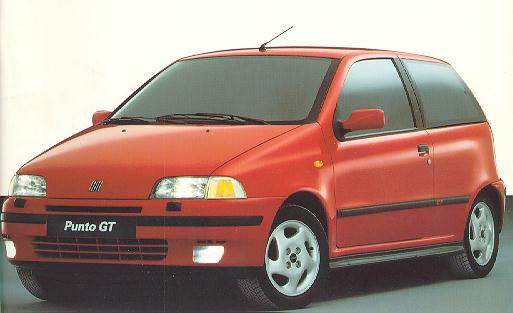
The GT has
a high quality, well balanced chassis with the light and nippy Punto
steering. It has the potential to become a true road going catapult
- and the Fiat badge also ensures that it's under-rated by the over-whelming
mass of British car snobs.. so second hand values provide big value
for money! The popularity of these mark1 Puntos actually increased in
the UK during their life. Introduced in 1994, they were superceded by
the Mark 2 shape in 1999. The best UK sales years for the model came
in 1997-8.
The Punto GT was available as a three door only. On its UK launch in
1995, at £10,995 it cost twice the Punto 55's price (the UK base
model). The GT was also fitted with ABS and airbags, alloy wheels, low
profile tyres and a six speaker stereo system. Additional electric goodies,
included a Tipo style electric sunroof, electric door mirrors, and head
lamp washers. There is little outside to betray
this car's performance pedigree. Apart from the
standard alloys there are no fancy spoilers or scoops around to make
a bold statement. Inside the subtlety (or boredom?) continues,
with a neat leather-trimmed steering wheel and matching gear knob plus
red dials setting the GT apart. Otherwise only the boost gauge betrays
a difference from the standard Punto. Fiat definitely missed a trick
with lack of availability of their Abarth body kits early in Punto GT
production.
There were
three variants of the Punto GT produced during its production life.
The first GT series, made from 1993-1995 had the
most powerful engine, with rear badging lettering no different from
the Standard Mk1 Puntos. A second series (1995-1997) had a revised engine,
and rear badging with bigger GT red logo. The third series (1997-1999)
had a revised ECU map updated to meet more severe emissions controls
- and had a less powerful engine. The alloy wheels of this last series
were also dark grey.
Punto GT 1995 Spec
| Punto
GT variants |
| Series: |
Max Power-bhp |
| Series 1 93-95 |
136 @5750rpm |
| Series 2 95-97 |
133 @5750rpm |
| Series 3 97-99 |
130 @5600rpm |
| Torque (all series)
153 lbs/ft |
Engine:
4 cylinder inline - transverse installation
Head:
SOHC 8-valve
Capacity: 1372cc
Aspiration:
Turbo (IHI)
Induction: injection, multi point with plenum & intercooler
Management:
Weber Marelli running 1.3 bar (19psi) as standard
Transmission
Box:
6 speed forward + reverse
Suspension:
front: Macpherson strut with lower wishbone, and anti roll bar
rear: independent, beam axle with trailing arms, strut with offset
spring, anti roll bar
Tyres:
185/55 R14
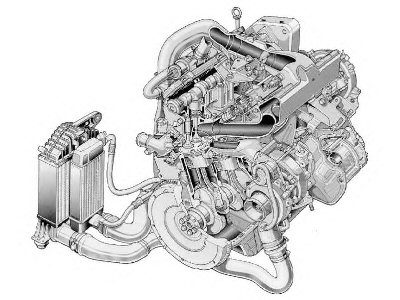
Weight: 1000kg
Max
Power: 136bhp @ 5750 rpm
Max Torque 153lbs/ft (204Nm) @ 3000 rpm
Top Speed: 125mph
0-62mph
(0-100km/h): 7.9 secs
You should
note from the spec in particular the torque figures - the turbo gives
this car a kick from low down (like a mule) - and there's plenty more
to come in modified form. The Uno Turbo demonstrated how well this engine
responds to turbo-charging. Perhaps the only thing that lets the GT
package down is its all up weight. At 1000kg, although quicker than
the standard Uno Turbo, the Punto would have a job to keep up with the
tuned Unos. Best to take some of the weight out perhaps - lots of electric
motors to lose for a start. Despite the weight penalty the GT is a match
for the European hot hatch and super mini opposition.
Driving
- Taming the GT
So the turbo's
quite big for the engine's size - which means not too much goes on under
two and a half thousand rpm. After that its going to keep up with any
of its opposition. You need to keep the turbo spinning - and this may
explain why the GT was the first of the sohc engined road Fiats to have
a six speed box. Some stick stirring is required to make it really motor!
Hold on - lets
run by that one again.... below 2500rpm not too much is going on....
and at 3000rpm (see spec) we are producing maximum torque.... that's
one hell of a torque curve! You need to be ready for the car to rear
up... any bad road surfaces or cambers do tend to make the GT track
off line... best to keep your foot 'in' on the loud pedal and focus
on steering a bit more! This sort of behaviour will reward you with
oodles more power and acceleration.
Deep into the
corners the car betrays little roll - you'll be glad of the legendary
Fiat stiff-ish 'driver's car' ride. Then comes the tyre slip, pile on
more and understeer sets in, lift and the car should snap back into
line (if all is not already lost!). The GT is at its best in long sweeping
bends, preferably coming in combinations. Any suspension play shows
up in tighter stuff when the limits of the suspension package becomes
more apparent. The Punto gets distinctly 'clunky' in response to the
tighter bends. As a second hand buy it will reward you to make sure
all the bushes and suspension joints are at their very best so plan
and budget to replace them with Powerflex or Proflex items.
On track days
I've noticed how much the GT relies on the tyre tread edge with the
side wall to retain feel and direction. It works the tread rims on the
front very hard. 'Cook' this beading edge and its best to swap the tyres
with the rear or else be prepared to combat side slip taking over earlier
and earlier. Also if you do go about 'pedal to the metal' then the fuel
consumption takes a big hit too. The Punto GT is a performance first/
economy in the back seat sort of motor. You'll quickly learn to know
just when and how long to use the turbo to extract a cruising economy.
Modifying the
GT puts the car into its element. Running 1.6 bar boost is probably
the first stop. But a warning - despite the addition of better brakes
and suspension a tuned Punto GT is fast enough to require careful placement
and applied concentration - as the limits of its handling and road manners
are then easily reached. Many of the club's cars have
ended prematurely in car graveyards as a result. If you add heavy ICE
sound systems to the already 'lardy' 1000kg all up weight this will
only add to the 'lateral' bad behaviour when on the limit. Having
said all that, a well tuned and well set up Punto GT is a performance
driver's delight.
Grama 2 Punto - the Puntograle
The Grama 2
Punto - or Puntograle as it has often been called - was a one-off publicity
vehicle for Maggiora (who also built the Punto Rally and S1600) when
the last of the Evo 2 Delta Integrales were being delivered during October
1994. They designed and built the car at a time when they had taken
over production of the Evo2 Delta Integrales at Chivasso and it was
originally shown at a party there to celebrate the last production batch
of the famous Delta Integrale.
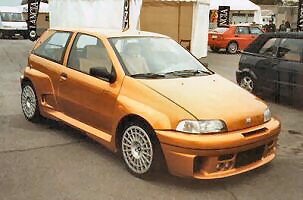
The overall
impression of the car is just stunning.... it has been carefully crafted
to look like a Punto Mk1 GT. This is a trick as the Punto body has been
grafted onto a Dedra Integrale floor pan - so this Punto has four wheel
drive and an Integrale engine!
Easy to say
- but the Dedra floorpan happens to be about 12 inches longer than the
Punto's body. The use of special front and rear valences with an additional
7inches depth disguise the floor pan’s length, while wheel arch
and sill extensions blend away the 6 inches of additional track width.
The size of the 17inch Integrale rims, shod with 205/45 tyres, does
much to distract the eye into thinking all is ‘Punto’ normal
– as does the all gold paint finish. The wheels provide the only
hint that the Delta’s 4 wheel drive system lies beneath.
I've
never seen this car in 'reality' to have a detailed look at their engineering
choices - so if anyone has had a close look I'd love to know more. If
I was doing this, I'd look to align the front bulkhead with the floor
pan bulkhead position, then make the (small) change to the front cross
member and its postion to get the drive shaft/axle line right. Most
of the correction of wheel base would then be achieved at the rear of
the floor pan (to get the wheel base right for the Punto shell) - but
using the Dedra suspension mounts and cutting the Dedra floorpan forward
of the suspension at a convenient point to retain the 4WD kit mounts.
Then you'd need only a shorter rear drive 'prop' shaft. The 'catch'
with this approach is that there wouldn't be enough room in a standard
Punto engine bay for the Integrale induction/injector set up (unless
you lost the heater area and re built the area under the windscreen)...
and the rear seat space may look odd (where the floor pan chopping was
done)?
Originally
the project’s single chassis was fitted out with an 8-valve Delta
unit. But trials with the car convinced them it was capable of constraining
a full on 16-valve turbo Integrale spec. Power is quoted at over 220bhp
@ 5750rpm. Top speed is estimated ‘above 220kph’ while its
gearing is thought to be rally spec derived and short – so acceleration
is abrupt and brutal!
Punto Abarth?
Even in 1993,
before the launch of the early cars there was press gossip about the
new Punto and speculation about its Abarth performance model. When the
Mk1 was launched rumours of a Punto Abarth - either from Fiat or third
parties continued.
Speculation
was certainly fueled by the presence of some styling prototypes within
Fiat. A real Punto Abarth was, indeed, prepared during 1993.
This prototype
was largely a cosmetic re-work of the Punto Mk1 with valences, exhaust
box and tail pipe, different headlights, bonnet vents, flared arches
and lower side skirts - all topped off with a rear roof line aero foil.
It was coloured light metallic grey, and bedecked with a suitable number
of Abarth badges. One idea that was carried into the later Abarth body
kit was the shape and venting on the front valence. (I'm waiting for
permission to publish some pictures of this car.) There were rumours
in the Italian Car Mags that this prototype Abarth GT also had some
tuning modifications based on a normally aspirated Coupe with viscodrive
traction control - or later that the Barchetta engine was used with
a six speed box.
Other body
shops presented similar styling exercises, but Fiat only produced an
Abarth body kit with the launch of the Punto Mk2.
Fiat's
Abarth body kit for the Mk2 would fit any model, although in the UK
it was initially associated more strongly with the Punto HGT which could
be ordered with the kit ready fitted. The kit comprised:
- larger light-alloy wheels
- front & lower rear spoiler
- rear roof aero foil
- additional side skirts
- customised gear stick, handbrake & pedal set
in aluminium
- customised steering wheel
- Abarth badges and logos
Within one year these items could be ordered individually, The complete
kit retailed for around £1200.
The only true
performance Punto to carry the Abarth name was the Punto Rally - that
was based on the Punto Mk2 HGT, and homologated in three forms for various
national and international rally championships.
Punto
HGT
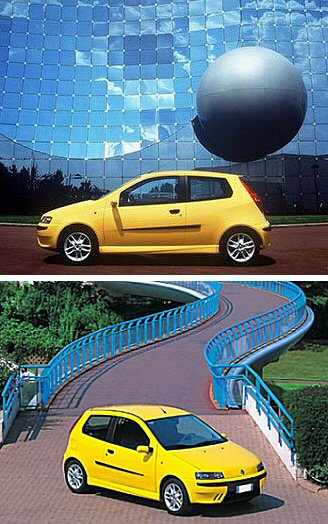
In 1999 Fiat's
new Punto range included two performance versions. The great little
Sporting was powered by the great little 1.2 litre 16-valve engine.
The second fast Punto was the HGT. While the Sporting could be described
as nippy, the HGT has some serious performance. It's 1.8 litre 16-valve
engine gave a top speed of 127 mph and 0 to 62 mph in just 8.6 seconds
- which nearly matched the Punto GT it replaced, just slower accelerating
It had style
and equipment with traction control, bolstered seats, unique alloy wheels,
and discrete side skirts. Less easy to spot were the ventilated front
disc brakes, and ABS. The HGT came with a rash
of features; electrical tilt and slide sun-roof, windows, adjustable
& heated exterior mirrors, front fog lamps, height adjustable steering
and driver’s seat. It introduced Fiat’s excellent dual mode
power steering, driver's adjustable lumbar support and a driver’s
airbag.
The revised suspension will happily absorb road bumps yet when cornering
hard it remains flat, mostly devoid of any lean and wallow. For the
same reasons your back seat passengers will find it choppy.
Under the
bonnet
This is a car that just begs to be driven enthusiastically, and when
you do, it rewards you in as all the best Fiats can and should. The
throttle response is immediate, and the variable inlet and variable
valve timing contribute to a large and flat torque curve (at 164Nm max
and never less than 144Nm between 1800 & 6500rpm!). This partly
explains why the HGT feels quicker than the 130bhp max power quoted
for the engine. It demands to be revved - like all its sporting ancestors.
For me, all the car lacks is another 30bhp! But then it would start
to embarrass larger performance cars in the Fiat Group - and I always
get the feeling that Fiat keep this pecking order very much in mind.
The HGT traction control system can be switched off if and when you
want (its not really been programmed for on the limit track day stuff),
the dual weight power assisted steering is un-intrusive, and when the
time comes to stop the all round disc brakes are all there too. Overall
the feel of this Punto is of maturity - it feels more solid than the
earlier versions. It doesn't raise the pulse the same as the ruder GT
did though. Overall the HGT is a well sorted thoroughbred.
Racing
Pedigree
The HGT's motorsport
potential has not been lost on many race series organisers around the
world. The head's breathing characteristics are excellent, and on top
of one of the best engines Fiat have ever designed. This engine was
originally introduced in the Barchetta, and is also present in the Bravo
range. It is the one to look for. For the less technical readers, good
breathing and a strong bottom end on the engine makes for powerful tuning
opportunites, and quick cars. Barchetta owners please note - you have
an easily tuned monster under your bonnets too!
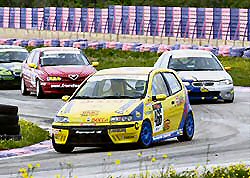
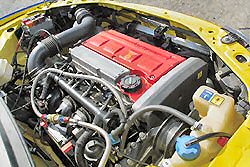
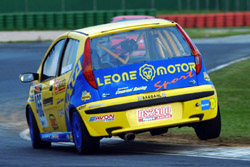
Punto
Rally Abarth
Late in 1999,
Fiat announced their return to the International Rallying spotlight.
It had been six long years since the Group withdrew from World Rallying
with the all conquering Delta Integrales. Now they returned with the
Punto - targeted at the World Junior Rally Championship for 1600cc cars
and under 28 year old drivers. Behind the car the Group had pooled elements
of the Chivasso based Lancia performance engineering, including the
remnants of Abarth within Fiat Auto Corsa. This has become N Technology
who continue to carry out development and testing today.
|
|
Abarth's
premises on Corso March had been used since 1962. Abarth were
bought by Fiat in 1971. All development work continued there
until the closure and move to part of the vast Chivasso Works
during 1992-3 (where the last of the Delta Integrales were also
being made by Maggiora).
At
this point their name changed to Fiat Auto Corsa. High
performance system development, and both competition and performance
car support continued.
Most
recently a collaboration under the name N Technology was formed.
This comprises the partnership interests of Nordauto, Andrea
de Adamanche and Fiat - taking on the roles of Fiat Auto Corsa.
They
are the design centre behind the Punto Rally.
|
Fiat had been
supporting grass roots competition in Italy throughout, but intended
to develop the Punto rally for use in the FIA Super1600 and World Junior
Rally Championship as an 'off the shelf'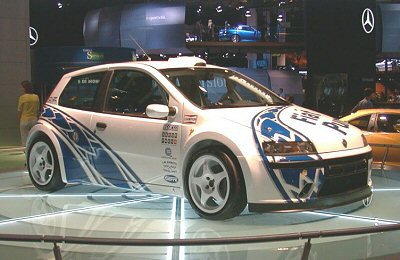 European Rally winner in these 1600cc Championships. This meant a head
to head fight against the Peugeot 106 Maxi, Citroen Saxo and Ford Puma
rally kit cars. Fiat homologated three versions of the Punto. One as
a show room category based on the original Punto HGT, one for domestic
rallying based on the same car and the third being the Punto Rally based
on the latest HGT model but fully exploiting the Group A rally kit car
and K/10 class modifications. So although the Punto Rally is based on
an HGT body shell, it has a wider track both front and rear (122mm wider
and 40mm lower), composite wings, valences, doors and bonnet. Its roof
level rear aero foil and scoop complete an aggressive and purposeful
looking package. And the Rally handles as good as it looks too - even
if the deep front air dam and lack of suspension travel confirms its
credentials as a tarmac rather than loose rally winner.
European Rally winner in these 1600cc Championships. This meant a head
to head fight against the Peugeot 106 Maxi, Citroen Saxo and Ford Puma
rally kit cars. Fiat homologated three versions of the Punto. One as
a show room category based on the original Punto HGT, one for domestic
rallying based on the same car and the third being the Punto Rally based
on the latest HGT model but fully exploiting the Group A rally kit car
and K/10 class modifications. So although the Punto Rally is based on
an HGT body shell, it has a wider track both front and rear (122mm wider
and 40mm lower), composite wings, valences, doors and bonnet. Its roof
level rear aero foil and scoop complete an aggressive and purposeful
looking package. And the Rally handles as good as it looks too - even
if the deep front air dam and lack of suspension travel confirms its
credentials as a tarmac rather than loose rally winner.
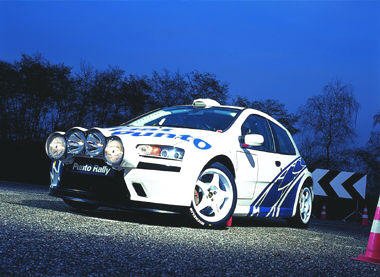 In
Group A form, the Punto
Rally's suspension retains its original MacPherson strut layout but
with revisions. The upgraded suspension exploits the car's wider body.
It comes in two versions; one for asphalt and the other for loose surfaces.
A light alloy strut at the front is combined with Bilstein dual-setting
hydraulic-pneumatic dampers. The rear end is fitted with an advanced
version of the standard production torsion beam and offset spring axle.
All joints are of the Uniball type. The car is stylishly shown with
one of two versions of the light competition alloy wheels measure 7j
x 17in (tarmac roads) and 6j x 16in (loose surfaces).
In
Group A form, the Punto
Rally's suspension retains its original MacPherson strut layout but
with revisions. The upgraded suspension exploits the car's wider body.
It comes in two versions; one for asphalt and the other for loose surfaces.
A light alloy strut at the front is combined with Bilstein dual-setting
hydraulic-pneumatic dampers. The rear end is fitted with an advanced
version of the standard production torsion beam and offset spring axle.
All joints are of the Uniball type. The car is stylishly shown with
one of two versions of the light competition alloy wheels measure 7j
x 17in (tarmac roads) and 6j x 16in (loose surfaces).
Although the
ride height is variable - as already mentioned - this car is very obviously
aimed towards domination on tarmac first - in keeping with many of its
intended Mediterranean venues. Suspension travel on the loose could
be more of a problem. But the Punto Rally looks great and corners even
better on the tarmac roads.
It arrives
with factory-fitted safety devices and is practically ready to drive
out onto the track. The only preparation needed is to adjust the suspension
set-up. So for 79k a rally team saves time and effort as the seats trim
and suspension have already been removed and suitable competition items
installed. A glance inside or in the engine bay
and there is no doubting this car's pedigree. Inside the car, the competition
bucket seats are immediately apparent. A long (hand height) short throw
gear stick protrudes from between. Beneath it is a fully sequential
6 speed box with a single plate, metal/ceramic clutch. This is linked
to a self-locking segmented diff. limited slip transmission. Stopping
power is provided courtesy of Brembo calipers and discs. While the rear
calipers are standard HGT items, the front disc/ caliper combination
can be swapped to suit the event. The system also features front and
rear load proportioning valves and a driver controlled regulator.
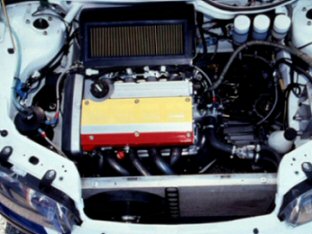
Punto Rally
Engine
The engine
is clean revving, noisy and robust. It is the HGT's twin cam 1.8 litre
16 valve - but with a special short throw crankshaft reducing the engine's
capacity to 1579cc. With a new design of racing pistons and con rods,
215bhp is the quoted maximum power at 9000rpm - that's 85bhp more than
the HGT - but we know there will be more to come from this set up! A
special integrated ignition and fueling/injection system has been added
by Magneti-Marelli.
This does little
to explain the savage burst of torque from mid revs all the way up to
the red line. The engine has been subtly but comprehensively re-engineered.
But it is an easy car to drive quickly and a welcome addition to the
Family of Fast Fiats.
2003 Punto
Rally Changes
Introduction of revision B to the Punto Mk2 (mod.188) required changes
to the Punto Rally. In addition there has been FIA talk of limiting
a new regional rally competition to one make/model with a view to cost
cutting. And Fiat needed to place the Fiat Punto as a leading candidate
in Super1600 as a result. The Punto Rally remains very competitive,
and needs to keep pace with the new batch of cars. Ford introduced the
new Ford Fiesta Super1600 replacing the Puma, and Citroen brought in
the C2 Super1600 in place of Citroen Saxo.
So the 2003 Punto Rally looks different - in particular the whole front
profile has changed as have the intakes and ventilation system behind.
The front arches have been blended into the car's body lines, and the
rear aerodynamics improved with different aero foil and smoother lower
rear bumper - now the same as the production models.

Changes
for 2004
N Technology have commissioned a range of small changes to the Punto
Rally for the 2004 variant. In particular an all new version of the
rear brakes was introduced. The new rear discs are made of a lighter
alloy and cross drilled 'reducing rotating masses and brake temperatures'
according to Fiat's publicity release. The Rally's previous rear disks
were standard HGT items.

Press
Release 23.11.04
Basso's
Punto Abarth takes 2nd place in Super 1600 category at Catalunya Rally
The Fiat Punto Abarth of Giandomenico Basso and Mitia Dotta took an
excellent second place in the Super 1600 category at the last event
in the Junior World Rally Championship, held in Spain recently.
After having held the lead for most of the Catalunya Rally (from halfway
through the first stage, to the second-last special speed trial of the
second stage), the wrong choice of tyres allowed them to be overtaken
by the French driver Bernardi in a Renault. Bernardi won the race from
Basso and the Swede Andersson (Suzuki), whose third place gave him the
Junior 2004 title.
The exploits of Basso's Fiat Punto Abarth in this rally echoed those
of Paolo Andreucci at the Italia Sardinia Rally, where his Fiat Punto
Abarth also finished second. In Sardinia the cars were tested on dirt
roads, whereas in Spain their reliability and competitiveness was put
to the test on tarmac. Once again the car was assisted directly by the
N.Technology test team, which gained important indications from the
experience for further developments to components such as road trim
and engine. Fatigue tests of the engineering during the race gave very
encouraging results, with no important mechanical component breaking.
Press
Release 29.10.03
Punto
Abarth Wins Italian Rally Championship
| Fiat
and Rallying |
| If
we exclude the considerable successes under the Lancia badge,
Fiat has won 3 World Manufacturers titles, 1 Drivers title, 3
European titles and 5 Italian titles.
Italy:
Fiat's
first success in the Italian Championship dates back to 1970:
Alcide Paganelli and Ninni Russo won with the Fiat 124 Spider.
Four
years later Maurizio Verini won in the same Championship with
the Fiat 124 Abarth, followed by Roberto Cambiaghi in the next
season.
Then
it was a Fiat 131 Abarth that took Adartico Vudafieri to victory
in the Italian Championship in 1980.
Europe:
In
Europe Raffaele Pinto won with the Fiat 124 Spider and Abarth
in 1972. A revised 124 Abarth won the title yet again in 1974,
this time with Verini, and Vudafieri also won in Europe in 1981
with the 131 Abarth.
World
Rally:
The
most prestigious titles were the World Manufacturer's Championship
triumphs in 1977, 1978 and 1981 with the 131 Abarth, and Walter
Röhrl's Drivers title in 1980. |
The
Punto Abarth has won the Italian Drivers and Manufacturers Rally Championship,
a return to success for Fiat after 23 years when, in 1980, Adartico
Vudafieri won the national titles with a Fiat 131 Abarth.
Paolo Andreucci and Giandomenico Basso finished in first and second
places respectively in the Drivers Championship in a season dominated
by the Fiat Punto Abarth, with six wins out of nine races. Andreucci,
teamed up with Anna Andreussi, was the winner in the Targa Florio, San
Martino di Castrozza and Adriatic Rallies, while Basso took first place
in the Ciocco, 1000 Miglia and Eastern Alps Rallies. In the Championship
standings they finished ahead of official Peugeot driver, Renato Travaglia,
Subaru drivers, Piero Longhi and Alessandro Fiorio, and Mitsubishi's
lead driver, Gianluigi Galli.
The 2003 Italian Championship was open to cars in the Super 1600 (the
Fiat Punto Abarth's category) and Super N categories (4-wheel drive
with a 2000 cc turbo engine). The Super 1600 version of the Fiat Punto
Abarth is equipped with a 1600 cc engine (a reduced-capacity 1800 cc
unit from the production line HGT version) with a power output of 215
bhp at 8250 rpm and a 6-speed sequential gearbox. The car is also fitted
with wider front and rear wings and rear spoiler. Both Andreucci and
Basso used Pirelli tyres.
The Fiat Punto Abarth was unbeatable in rallies over tarmac, while in
off-road conditions Andreucci chalked up a great success in the Adriatic
Rally thanks to the car's outstanding reliability that enabled it to
get the better of its four-wheel drive rivals. Winning outside Italy,
too. The Fiat Punto Abarth has also shown itself to be highly competitive
outside the Italian Championship. In fact in the World Junior Championship
(for drivers aged under 28) it achieved an outstanding success in the
San Remo Rally with a win for Mirco Baldacci and a second place in the
Monte Carlo Rally with Marco Ligato.
In Greece, Laveris took the national title in a Punto Abarth with one
rally to go, while Cols in Belgium has already won the Super 1600 title
(Drivers and Manufacturers) thanks to five victories. And Fiat Punto
Abarth drivers are still in the running for the titles in Portugal,
the UK and Poland. Instead Isik, at the wheel of a Fiat Palio Super
1600 version, has also won the Championship title in Turkey.
 About
N Technology
About
N Technology
A
considerable investment has gone into the development of N technology,
to promote and manage motorsport within the Fiat Group.
Their
Fiat Programme...
Combines both
race and rally support. In the rally sector, N.Technology
together with Fiat Abarth Racing Team takes part in the FIA Junior World
Rally Championship, FIA European Rally Championship and Italian Rally
Championship for Fiat.
They compete
with the Fiat Punto Abarth Rally Super 1600, designed, developed and
managed by N.Technology. Their achievements include:
2002 - Italian
Rally Championship : Winner of Super 1600 and 2WD Cars Classification
2003 - Italian
Rally Championship : Winner of Manufacturers and Drivers (Overall),
Super 1600 and Under 25 Driver Classifications
2004
- Italian Rally Championship : Winner of Super 1600 Classification
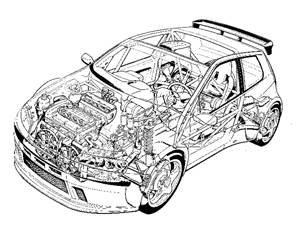
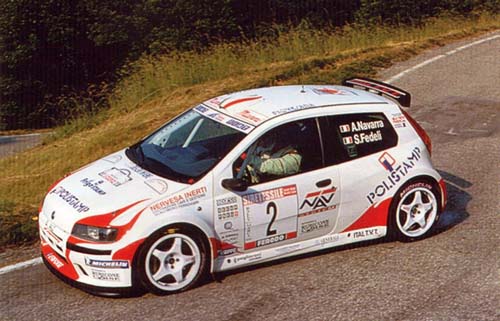
N.Technology
have also managed the organization and coordination of the Fiat Abarth
Trophy. This has historically provided both driver nursery and rally
car testing ground... having been created in the seventies to help grow
on new talents. This series of Italian national events embraces high
visibility rally Championships like the Campionato Italiano Rally, Trofeo
Rally Asfalto, Trofeo Rally Terra, Challenge Ronde, Rallysprint and
Formula Start.
The
Fiat models used are the Punto Abarth Rally (Super 1600) and Stilo Abarth
Rally (Trofeo), manufactured and supported by N.Technology. Within the
Fiat Abarth Trophy, the Fiat Punto 1.8 HGT (Gruppo A e N), Fiat Stilo
1.8 16v (Gruppo A e N) and Formula Start (production cars; Fiat Punto
1.2 16v, 1.4 16v e 1.3 Diesel Multijet, Fiat Panda 1.2 and 1.3 Diesel
Multijet) are eligible. And these Championships, with the relevant special
leaguetables, seem to be much sought after by young drivers, as launching
pads to their future careers.
Alfa
Romeo Programme
In contrast their Alfa Romeo programme has a circuit
racing emphasis. Together with Alfa Romeo Racing Team they compete in
the FIA World Touring Car Championship on behalf of Alfa Romeo, with
the Alfa Romeo 156 Super 2000, designed, developed and managed by N.Technology
Palmares.
Recent successes
have included
- FIA ETCC : 2002
– Winner of Manufacturers and Drivers Classification (together with
GTA Racing Team Nordauto)
- FIA ETCC : 2003 – Winner of Drivers and Teams Classification (together
with AutoDelta Squadra Corse)
- FIA ETCC : 2004
– Winner of Teams Classification (together with AutoDelta Squadra Corse)
N.Technology also manages for Alfa Romeo the coordination and organization
of the European Alfa Challenge. This Promotional Trophy, which is run
with the Alfa Romeo 147 GTA CUP, is an important testing ground for
young rising drivers, for which there is a special Under 25 Prize. The
European Alfa Challenge Trophy takes place on the most important international
circuits. And N.Technology is in charge of its design, set-up and development.
It is a very popular sporting event, which attracts each year great
public interest and important links for the future development of the
series.
Links
N
Technology
Mariotti
Racing nice punto mk1 conversion amongst their ventures!
Elaborare
Supplier
Links
| Supplier |
Suspension
/Brakes |
Springs |
Strut
Brace |
Air
Filter /Box |
Exhaust |
Website |
| Koni |
• |
|
|
|
|
|
| Eibach |
• |
• |
• |
|
|
|
| Bilstein |
• |
• |
|
|
|
|
| Leda |
• |
|
|
|
|
|
| Spax |
• |
• |
|
|
|
|
| Avo |
• |
• |
|
|
|
|
| OMP |
• |
• |
• |
|
• |
|
| Hormann |
• |
• |
|
|
• |
|
| Novitech |
• |
• |
|
• |
• |
|
| K&N |
|
|
|
• |
|
|
| ITG |
|
|
|
• |
|
|
| Jamex |
|
• |
• |
|
|
|
| Sparco |
|
• |
• |
• |
|
|
| Pi |
|
• |
|
|
|
|
| Faulkner |
|
• |
|
|
|
|
| Janspeed |
• |
|
|
|
• |
|
| Powerflow |
|
|
|
|
• |
|
| Supersprint
Ansa |
|
|
|
|
• |
|
| Jetex |
|
|
|
|
• |
|
| Momo |
|
|
• |
|
• |
|
| Brembo |
• |
|
|
|
|
|

